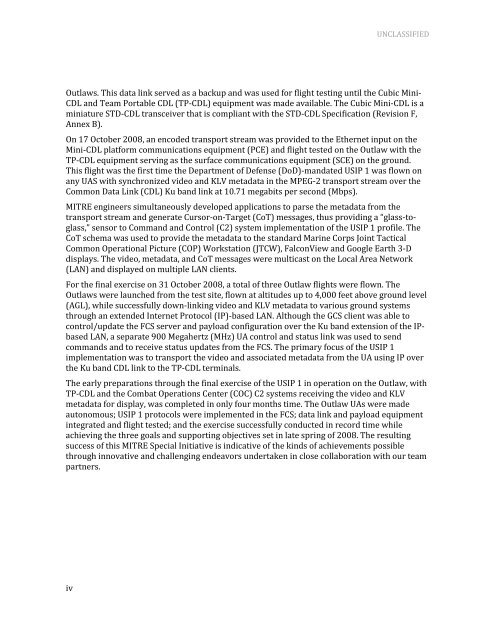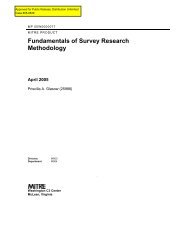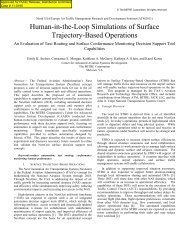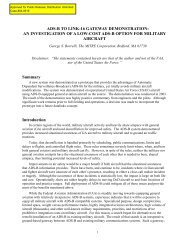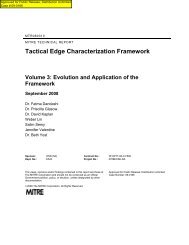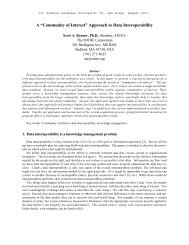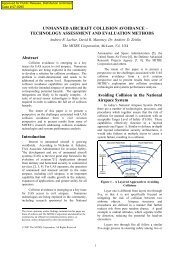Unmanned Aircraft System (UAS) Exercise to Assess ... - Mitre
Unmanned Aircraft System (UAS) Exercise to Assess ... - Mitre
Unmanned Aircraft System (UAS) Exercise to Assess ... - Mitre
Create successful ePaper yourself
Turn your PDF publications into a flip-book with our unique Google optimized e-Paper software.
iv<br />
UNCLASSIFIED<br />
Outlaws. This data link served as a backup and was used for flight testing until the Cubic Mini-<br />
CDL and Team Portable CDL (TP-CDL) equipment was made available. The Cubic Mini-CDL is a<br />
miniature STD-CDL transceiver that is compliant with the STD-CDL Specification (Revision F,<br />
Annex B).<br />
On 17 Oc<strong>to</strong>ber 2008, an encoded transport stream was provided <strong>to</strong> the Ethernet input on the<br />
Mini-CDL platform communications equipment (PCE) and flight tested on the Outlaw with the<br />
TP-CDL equipment serving as the surface communications equipment (SCE) on the ground.<br />
This flight was the first time the Department of Defense (DoD)-mandated USIP 1 was flown on<br />
any <strong>UAS</strong> with synchronized video and KLV metadata in the MPEG-2 transport stream over the<br />
Common Data Link (CDL) Ku band link at 10.71 megabits per second (Mbps).<br />
MITRE engineers simultaneously developed applications <strong>to</strong> parse the metadata from the<br />
transport stream and generate Cursor-on-Target (CoT) messages, thus providing a “glass-<strong>to</strong>glass,”<br />
sensor <strong>to</strong> Command and Control (C2) system implementation of the USIP 1 profile. The<br />
CoT schema was used <strong>to</strong> provide the metadata <strong>to</strong> the standard Marine Corps Joint Tactical<br />
Common Operational Picture (COP) Workstation (JTCW), FalconView and Google Earth 3-D<br />
displays. The video, metadata, and CoT messages were multicast on the Local Area Network<br />
(LAN) and displayed on multiple LAN clients.<br />
For the final exercise on 31 Oc<strong>to</strong>ber 2008, a <strong>to</strong>tal of three Outlaw flights were flown. The<br />
Outlaws were launched from the test site, flown at altitudes up <strong>to</strong> 4,000 feet above ground level<br />
(AGL), while successfully down-linking video and KLV metadata <strong>to</strong> various ground systems<br />
through an extended Internet Pro<strong>to</strong>col (IP)-based LAN. Although the GCS client was able <strong>to</strong><br />
control/update the FCS server and payload configuration over the Ku band extension of the IPbased<br />
LAN, a separate 900 Megahertz (MHz) UA control and status link was used <strong>to</strong> send<br />
commands and <strong>to</strong> receive status updates from the FCS. The primary focus of the USIP 1<br />
implementation was <strong>to</strong> transport the video and associated metadata from the UA using IP over<br />
the Ku band CDL link <strong>to</strong> the TP-CDL terminals.<br />
The early preparations through the final exercise of the USIP 1 in operation on the Outlaw, with<br />
TP-CDL and the Combat Operations Center (COC) C2 systems receiving the video and KLV<br />
metadata for display, was completed in only four months time. The Outlaw UAs were made<br />
au<strong>to</strong>nomous; USIP 1 pro<strong>to</strong>cols were implemented in the FCS; data link and payload equipment<br />
integrated and flight tested; and the exercise successfully conducted in record time while<br />
achieving the three goals and supporting objectives set in late spring of 2008. The resulting<br />
success of this MITRE Special Initiative is indicative of the kinds of achievements possible<br />
through innovative and challenging endeavors undertaken in close collaboration with our team<br />
partners.


